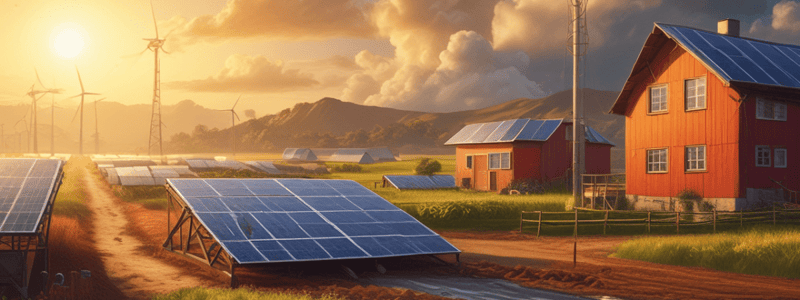Podcast
Questions and Answers
What is the driving force behind climate according to the passage?
What is the driving force behind climate according to the passage?
- Precipitation and temperature
- The sun's energy (correct)
- Crop selection and management practices
- The atmosphere
Which of the following factors does the passage mention as influencing the solar energy received on Earth?
Which of the following factors does the passage mention as influencing the solar energy received on Earth?
- Latitude, season, and time of day (correct)
- Crop and season
- Inclination of the earth, orbit, daily spin, light quality, duration, and intensity
- Pollution
What are the four main layers of the Earth's atmosphere according to the passage?
What are the four main layers of the Earth's atmosphere according to the passage?
- Troposphere, Stratosphere, Mesosphere, Thermosphere (correct)
- Troposphere, Stratosphere, Ionosphere, Thermosphere
- Troposphere, Atmosphere, Mesosphere, Thermosphere
- Atmosphere, Biosphere, Hydrosphere, Lithosphere
Which of the following functions of the Earth's atmosphere is mentioned in the passage?
Which of the following functions of the Earth's atmosphere is mentioned in the passage?
What is the significance of the light quality (420-460 nm and 620-680 nm) mentioned in the passage?
What is the significance of the light quality (420-460 nm and 620-680 nm) mentioned in the passage?
According to the passage, which of the following is not mentioned as an important management practice for agriculture?
According to the passage, which of the following is not mentioned as an important management practice for agriculture?
What is the relationship between the Earth's inclination, orbit, and daily spin mentioned in the passage?
What is the relationship between the Earth's inclination, orbit, and daily spin mentioned in the passage?
What is the main purpose of the images provided in the passage?
What is the main purpose of the images provided in the passage?
Which of the following is NOT mentioned in the passage as an important factor for agricultural practices?
Which of the following is NOT mentioned in the passage as an important factor for agricultural practices?
What is the primary cause of global warming?
What is the primary cause of global warming?
What is one potential solution to global warming mentioned in the text?
What is one potential solution to global warming mentioned in the text?
What is the primary factor that determines the climate of a region?
What is the primary factor that determines the climate of a region?
Which of the following is NOT a feature important to agriculture, according to the text?
Which of the following is NOT a feature important to agriculture, according to the text?
What is the basis for today's climate classification systems?
What is the basis for today's climate classification systems?
What is the primary factor used in the Koppen climate classification system?
What is the primary factor used in the Koppen climate classification system?
How many major climate types are identified in the Koppen system?
How many major climate types are identified in the Koppen system?
Which of the following is NOT one of the major climate types identified in the Koppen system?
Which of the following is NOT one of the major climate types identified in the Koppen system?
What is the primary limitation of the Greek climate classification system mentioned in the text?
What is the primary limitation of the Greek climate classification system mentioned in the text?
Flashcards are hidden until you start studying
Study Notes
Climate Regulation
- Global warming refers to the increase in the earth's average air temperature, which may cause changes in crop production regions and increases in extreme weather.
- Greenhouse gases are associated with global warming, and reducing carbon dioxide is a potential solution.
Climate
- Climate is the typical long-term weather in a region, influenced by several factors: solar energy, bodies of water, land forms, elevation, and air masses.
- Precipitation and temperature are important features of climate that affect agriculture.
Climate Classification
- The Greek system is a very limited and general basis for today's climate classification systems.
- The Koppen system divides the earth into climatic regions based on temperature and precipitation, with five major climate types: tropical, dry, moist mid-latitude with mild winters, moist mid-latitude with cold winters, and polar climates.
The Sun's Energy
- The sun is the driving force behind climate, and the quality, duration, and intensity of its energy influence plants.
- The solar energy received is influenced by latitude, season, and time of day.
- Seasonal and day-length effects are caused by the interaction of the earth's inclination, yearly orbit, and daily spin.
Light Effect on Plants
- Light affects plants in three ways: light quality (420-460 & 620-680 nm), light duration, and light intensity.
Our Atmosphere
- The atmosphere is a gaseous layer extending up to 70 miles, composed of the troposphere, stratosphere, mesosphere, and thermosphere.
- The atmosphere has four functions: source of water vapor, protection from radiation, selective passage of radiation, and temperature regulation.
Studying That Suits You
Use AI to generate personalized quizzes and flashcards to suit your learning preferences.




